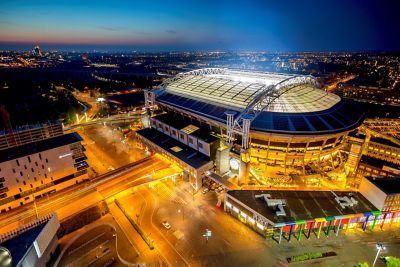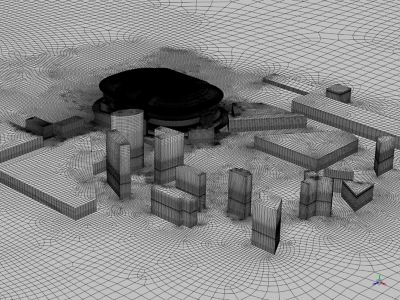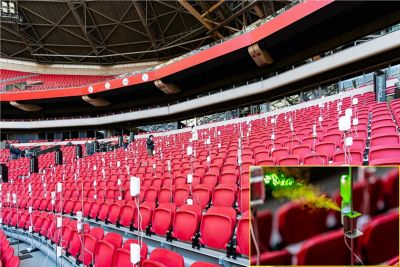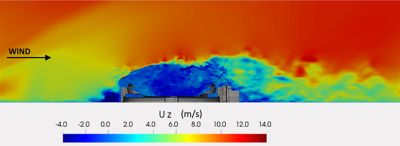-
-
Access Free Student Software
Ansys empowers the next generation of engineers
Students get free access to world-class simulation software.
-
Connect with Ansys Now!
Design your future
Connect with Ansys to explore how simulation can power your next breakthrough.
Countries & Regions
Free Trials
Products & Services
Learn
About
Back
Products & Services
Back
Learn
Ansys empowers the next generation of engineers
Students get free access to world-class simulation software.
Back
About
Design your future
Connect with Ansys to explore how simulation can power your next breakthrough.
Free Trials
ANSYS BLOG
July 22, 2022
What Have We Learned to Prevent Closing Stadiums Because of COVID?
Editor's note: Updated with additional information November 22, 2022.
February 19, 2020. Early in the pandemic, before lockdowns and suspension of sporting events. In Milan, Italy, 40,000 fans gathered to watch a Champions League Football (soccer) match between the Italian team Atalanta Bergamo and the Spanish team Valencia in San Siro stadium. Following the 4-1 win by Atalanta, local newspapers described it as a “magical” night for the fans in attendance. Two weeks later, when the halls of Bergamo hospitals were filled with people dying from Covid-19, one doctor had a different name for the sporting event: a “biological bomb.”
The game became widely known as “Game Zero,” the place where potentially the pandemic really started in Italy.
Professor Bert Blocken of the Eindhoven University of Technology in the Netherlands and KU Leuven in Belgium watched the thrilling game on television, then watched with sadness as the devastating results of such a large gathering of people emerged. Instead of doing nothing, he put his world-renowned knowledge and understanding of fluid flows and computational fluid dynamics simulation software to work to understand how Covid-19 particles trapped in aerosols — suspensions of fine solid or liquid particles in gas, in this case air — expelled from the mouths of cheering fans traveled in the stadium and could potentially build up to concentrations high enough to cause so many infections.
“A football stadium is not an outdoor environment,” Blocken says, especially these days when stadiums often have roofs with small openings and an enclosed circumference to protect fans from rain and wind. “That’s a good design in terms of fan comfort, but in terms of stadium ventilation when a pathogen like Covid is in the air, it can be counterproductive.”
So Blocken spent the next 18 months performing Ansys Fluent simulations of aerosol flows and build-up in stadiums, fitness centers, and classrooms. He validated his simulation results with extensive experiments involving artificial saliva in aerosol generators and sensors designed to emulate fans in stands when stadiums were closed to the public. And he explored how air cleaners could be used to make classrooms and fitness centers safer should Covid return in force.

The Johan Cruijff ArenA stadium in the Netherlands. Copyright Johan Cruijff ArenA
Simulating and Validating Aerosol Behavior in Stadiums
If you’ve ever watched a professional football (soccer) game, you know that the fans begin cheering and singing before the game starts and continue long after it is over. With every chant, droplets in a wide range of diameters fly from the fans’ mouths. Large droplets tend to travel only short distances before succumbing to the force of gravity, but the small aerosol particles can remain floating in the air for tens of minutes, even hours, and travel tens or hundreds of meters from the source. If you inhale one particle of the Covid virus, chances are you will not become infected, but frequent inhalation over a certain period of time could give you a high enough viral load or dose to make you sick. The constant replenishment of aerosol particles from human mouths for two hours or more can be dangerous if those particles contain the Covid virus from infected people.
To better understand how aerosols travel, Blocken took on the challenge of performing post-match forensics to determine what might have happened at that Milan stadium in February 2020.

A very fine mesh of the stadium and its surroundings was generated to capture aerosols movements.
“It’s very difficult to do this kind of ‘crime scene’ investigation afterwards and to see what really happened where and when,” Blocken says. “Many people argued that some of these infections could have happened during transport to and from the stadium, and of course that’s true. It has taken the world a long time to realize that aerosols are actually important here in this pandemic, and to realize that simulation could play a very important role in understanding how aerosols behave.”
In December 2020, when people were barred from watching games in person, Blocken and his team of graduate students first performed physical experiments in the empty Johan Cruyff Arena in Amsterdam. Using aerosol generators containing artificial saliva as substitutes for humans together with aerosol particle detectors in a small section of the stadium, they collected data on the size and concentration of aerosol particles as the weather conditions and the associated natural stadium ventilation changed from hour to hour and day to day.
A few months later, in March 2021, the Covid situation had improved enough that Blocken could validate the artificial aerosol study with 5,000 people in the stadium. The results verified that the December 2020 experiment had produced results that closely matched the aerosol distribution produced by people during a football match.
Still, these physical experiments fell far short of the complex reality of the scenario that Blocken wanted to study — a whole stadium full of people, at different elevations in the stadium, under varying wind speeds and directions, with a range of temperatures, with natural and mechanical ventilation. He estimates it would have taken more than a year to do all these physical experiments. Simulation made studying all these variations possible.
“Using Fluent simulations, we filled the entire stadium with people,” Blocken says. “We had them all exhaling at different intensities, we had them cheering. We had them wearing masks to reduce particle concentrations. We had different temperature conditions, different wind speeds.”

Artificially generated aerosols were used to validate the computer models.
Funded by the Dutch government organization Health-Holland and The White House Consortium consisting of Ansys and Microsoft, Blocken and his team performed CFD simulations using the Johan Cruyff Arena in Amsterdam as the model. The arena is surrounded by some high buildings, so they were also included in the 500 m by 500 m model because they would affect wind patterns inside the stadium. Using mesh sizes down to about 10 cm produced a large model containing approximately 30 million cells. The simulations also required using very small time steps for very long durations. The resulting 60,000 time steps made it necessary to run the Fluent simulations on powerful computers available from Microsoft Azure.
“This simulation setup gave us a very good view of what can happen in terms of actual aerosol concentrations and ventilation in the stadium,“ Blocken says, adding that wind speeds and direction and the ambient temperature proved to be important variables. “Maybe the most important thing with the simulation is that it allowed us to make an aerosol prediction protocol for the Johan Cruyff Arena. Because of so many conditions that we simulated based on the local weather forecast, we can actually now predict what the aerosol concentration will be on that specific game day.”
He hopes that should a new pandemic wave arise, stadium officials throughout the world will use his simulation protocol to make decisions about stadium closures on a case-by-case basis, rather than imposing months-long lockdowns that keep all fans at home.
“This pandemic has taken us largely by surprise and we should never allow anything like it to happen again,” Blocken concludes. “After this pandemic, let’s not go back to business as usual. Engineering solutions like ventilation and air cleaning exist, and engineering methods, computer simulations, and measurement protocols also exist at a top-quality level, so let’s all use them to fight aerosol-driven health issues (Covid, flu, pollen allergies, etc.).”

Streamwise velocity component in vertical cross-section through stadium.
Simulating Aerosol Concentrations in Fitness Centers and Classrooms
Besides sporting venues, Blocken’s team was also interested in keeping fitness centers and classrooms open during the pandemic, so people could keep fit and improve their moods through exercise, and children could learn in a group setting. So, they put simulation to work on these major challenges.
“If you count the aerosol particles present in the air in a one-liter volume, like a large bottle of water,” Blocken says, based on his physical experiments in a typical classroom, “you might find around 200,000 to 300,000 particles with diameters ranging from 10 microns to 0.25 microns. That includes aerosol particles from breathing, from traffic, from pollen. It’s a massive amount. So, you can imagine that in one liter, one very small volume, you could have a large viral load.”
Blocken’s team began to study aerosol concentration in fitness centers and classrooms using physical experiments and simulation in July 2020. They recruited 35 members of the student body and faculty of the Eindhoven University of Technology to quarantine in a hotel for two days prior to taking a Covid test to prove they were not infected. Following that, they exercised in 30-minute intervals at the university’s student sport center equipped with two new air cleaners and sensors to measure the size and concentration of aerosol particles in air.
Results of these experiments and Fluent simulations showed that by cleaning the air completely six times per hour you can reduce aerosol particle concentration down to 5 to 10 percent of their normal concentrations before the air cleaners were turned on.
Next, Blocken launched the 1000 Classrooms Project in December 2021 when he noticed that while vaccines, social distancing, and masking were being adopted in most countries, the world had a blind spot when it came to air cleaning. To combat this weakness, he assembled a consortium of government and private institutions to fund the study of the effectiveness of air cleaners in 1000 classrooms in Belgium and the Netherlands. Five hundred classrooms were equipped with air cleaners while the remaining 500 acted as experimental controls with no air cleaners. Again, the experiments and simulations confirmed that good air cleaners inside classrooms that recirculate the air six times per hour could keep students safe.
“If you use air cleaners at that capacity, you can reduce aerosol concentrations by 90 to 95%, Blocken says. “And if you put that in the typical aerosol infection equation, assuming an exposure time of two hours, that would reduce the risk of infection by a factor of 12.”
Recent developments have made Blocken optimistic that this research may have a profound effect in slowing the spread of future airborne respiratory illnesses.
“Our bottom-up approach is hopefully going to inspire governments to start large-scale deployment of air cleaning equipment,” he says, noting that Victoria, Australia, has bought 51,000 air cleaners to put in classrooms. Germany, the U.K., Belgium, and Finland have also started air cleaning initiatives. In the U.S., the White House has made $122 billion available for ventilation and air cleaning projects in schools.